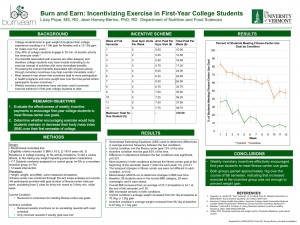“Physical activity has been identified as an important behavior to help prevent the development of overweight/obesity and associated conditions including diabetes, cardiovascular disease, and metabolic syndrome. Regular physical activity has also been found to improve dietary intake and patterns. Therefore, interventions targeting physical activity may lead to weight change not only by increasing calories expended each day, but also by influencing the food choices people make.” 1
Or so thought Nutritional Sciences Graduate student Lizzie Pope. So she designed a study to provide new information on the efficacy of using monetary incentives to help college freshmen meet physical activity guidelines, and therefore establish an important health-promoting behavior. It worked like this:
One hundred and seventeen students were randomized to one of three groups: continued-incentive, discontinued-incentive, or control. For 12 weeks during the fall semester both the continued-incentive and discontinued-incentive groups received weekly incentives for using the university fitness center. At the conclusion of fall semester weekly incentive payouts ended for both incentive groups. For 12 weeks during spring semester the discontinued-incentive group received no incentives to use the fitness center while the continued-incentive group received incentives on a variable-interval schedule, averaging one incentive payment each month. During the spring semester the exact schedule for the incentives was not known to participants in this group.
Great. But how was she going to track the students? Well, perhaps she could set up some sort of card swipe system that would record the student ID, date, and entry/exit times for each visit to the fitness center. Great, how do you do that?
Enter the Center for Teaching and Learning. Lizzie enlisted the aid of CTL staffer Wesley Wright. Together, Wesley and Lizzie assembled a Mac Mini computer and magnetic card reader. The Mac recorded each card swipe and entered the data into a central database. The database fed a web site, and the web site was used by the students to track their individual progress, using both tables and graphs. The web site also provided Lizzie with both individual and group statistics and the incentive payment owed to the students.
Results? “Basically, we were able to increase fitness-center use over the fall semester by paying weekly incentives,” says Lizzie, “however this increased exercise did not translate into weight maintenance for the incentive groups over the fall semester. In the spring semester without incentive payments our discontinued-incentive group no longer met fitness-center use goals. However, with a variable-interval payment schedule our continued-incentive group continued to meet fitness-center use goals. Unfortunately, this increased exercise again did not translate into weight maintenance over the spring semester. It would be interesting to measure body composition and metabolic markers to see if the increased exercise had beneficial effects other than weight control.”
1 “Burn and Earn: Incentivizing Physical Activity in College Freshman – UNIVERSITY OF VERMONT”, n.d. http://www.reeis.usda.gov/web/crisprojectpages/0223043-burn-and-earn-incentivizing-physical-activity-in-college-freshman.html.

